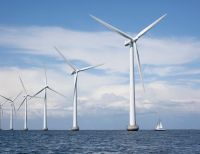- Name
- Johns Hopkins Media Relations
- [email protected]
- Office phone
- 443-997-9009
- JHUMediaTeam
The Inflation Reduction Act of 2022, passed today by the U.S. Congress, is considered by many to be the largest investment in the fight against climate change ever made by the federal government. The legislation commits $369 billion to programs in energy security and climate change mitigation over the next 10 years—all with the goal of reducing carbon emissions by roughly 40% by 2030 (compared to 2005 levels). The bill also provides substantial funding for environmental justice efforts to give vulnerable communities the resources to develop and implement the clean energy technologies supported by the legislation.
Experts on carbon, the power grid, energy storage, and wind energy from the Whiting School of Engineering's Ralph O'Connor Sustainable Energy Institute offer their reactions to the passage of this historic legislation.
Carbon
Jonah Erlebacher, a professor in the Department of Materials Science and Engineering, was thrilled about the bill and its potential impact on the research he is working on with Chao Wang, an associate professor in the Department of Chemical and Biomolecular Engineering. Erlebacher and Wang, both of whom are members of the ROSEI leadership council, are partnering on research that aims to pull harmful greenhouse gases out of the air and convert them to pure carbon, which can be useful in a range of industries such as farming and construction.
"The extension of tax credits for carbon dioxide capture and the introduction of credits for clean hydrogen generation are very exciting," Erlebacher said. "They should really drive innovation and adoption of advanced clean energy technologies like the ones being developed here at ROSEI."
Wang calls the Inflation Reduction Act a "big decision" and said he had been holding his breath as he followed the bill's trajectory—especially because of its enormous potential impact on decarbonizing the economy.
"We need that to save our planet," Wang said.
The power grid
Ben Hobbs—a professor of environmental management whose research focuses on using analysis and economics to improve electric utility planning, operations, and policy—was impressed that the federal government is making such a strong financial commitment through this legislation. He predicts it will have a large and positive impact on future technology choices and emissions. However, Hobbs also cautions that the bill alone won't accomplish everything needed to combat climate change and create a secure, sustainable energy future.
"There is much more to be done to achieve our zero carbon goals by midcentury," said Hobbs, who is also a member of the ROSEI leadership council. "Tax credits for clean technologies—the emphasis of this bill—are only a partial answer, and do very little, for instance, to incentivize minimizing emissions from operating the power plants that are in place at any given time or to motivate consumers to use less energy. Full decarbonization will be affordable if we use tax, utility pricing, and other policies to set a consistent price on carbon throughout the economy."
ROSEI affiliate Yury Dvorkin, an incoming associate research professor in the departments of Civil and Systems Engineering and Electrical and Computer Engineering, says the bill's broad approach has the potential to reach and impact households of various income levels.
"It makes a strong push across a wide range of clean energy technologies—wind, solar, batteries, electric vehicles, heat pumps and wind—which should provide flexibility in technological and financial choices in how every household could contribute to cutting emissions," said Dvorkin, whose research focuses on developing models and that will help society accommodate emerging smart grid technologies, such as such intermittent generation, demand response, storage, smart appliances, and cyber infrastructure. "In addition to this flexibility, the bill promotes energy justice by prioritizing structural efficiency of emissions reduction at the national level over placing a relatively undue burden of curtailing energy use on low-income households."
Energy storage
The Inflation Reduction Act also plays an important role in incentivizing energy storage and solar technology through consumer tax credits for both rooftop solar panels and electric cars. That's great news, says Susanna Thon, an associate professor in the Department of Electrical and Computer Engineering whose research focuses on manipulating materials at the nanoscale to give solar cells properties that help them both collect and store more energy.
"There is also a focus on low-income communities, as well as production-side tax credits to spur American manufacturing of solar panels, batteries, and many other clean technologies," said Thon, who is also a ROSEI leadership council member. "Critically, it provides needed funding for the national labs and [the Department of Energy] in areas that perfectly align with the goals of ROSEI's Light-Integrated Technology for Energy Storage (LITES) initiative around solar-integrated energy storage. We expect to see a near-term rapid expansion of research, manufacturing, and procurement of clean energy tech as a direct result of the IRA."
Wind
Charles Meneveau, a professor of mechanical engineering and an expert in the multiscale aspects of turbulence, large-eddy simulations, and wind farm fluid dynamics, predicts that the act will drastically improve efforts to electrify the transportation system, which can then be powered by sustainable wind and solar.
"Industry tax credits to incentivize renewables and seeking social equity via the creation of a National Green Bank are all game changers and significant steps forward," Meneveau said. "At ROSEI, we anticipate that our research on sustainable large-scale wind power can play a role in bringing about desired change based on the best science and engineering."














